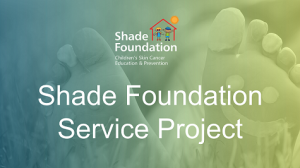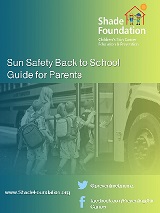Back to School Sun Safety Guide
It only takes 15 minutes to sustain a sunburn. That means whether our kids are walking to school or at running around in soccer practice, it’s important to stay sun safe!
Download the Shade Foundation’s
Back to School Sun Safety Guide to learn about:
- The risks of skin cancer
- Sun safety supplies for your kids
- What you need to know about your school’s sun safety policy
Skin Self-Exam Video
Understanding How to Prevent Skin Cancer
Protection from ultraviolet (UV) radiation is important all year round, NOT just during the
summer or at the beach. UV rays from the sun can still reach you on cloudy and hazy days.
UV rays reflect off of surfaces like water, cement, sand, and snow.
UV exposure is at the most dangerous between 10:00 am and 4:00 pm, so plan accordingly to limit how much time you and your children are at risk. UV rays from sunlight are the greatest during the late spring and early summer.
The CDC recommends easy options for protection from UV radiation:
Shade – Seek Shade, especially during midday hours
- You can reduce your risk of skin damage and skin cancer by seeking shade under an umbrella, tree, or other shelter before you need relief from the sun. Your best bet to protect your skin is to use sunscreen or wear protective clothing when you’re outside— even when you’re in the shade.
Clothing – Wear clothing to protect exposed skin
- Loose-fitting long-sleeved shirts and long pants made from tightly woven fabric offer the best protection from the sun’s UV rays. Darker colors can offer more protection than lighter colors.
Shade – Seek Shade, especially during midday hours
- You can reduce your risk of skin damage and skin cancer by seeking shade under an umbrella, tree, or other shelter before you need relief from the sun. Your best bet to protect your skin is to use sunscreen or wear protective clothing when you’re outside— even when you’re in the shade.
Hats – Wear a hat with a wide brim
- For the most protection, wear a hat with a brim all the way around that protects your face, ears, and the back of your neck. A tightly woven fabric, such as canvas, works best to protect your skin from UV rays. If you wear a baseball cap, you should also protect your ears and the back of your neck by wearing clothing that covers those areas, using sunscreen with at least SPF 30, or by staying in the shade.
Sunglasses – Wear sunglasses that block both UVA and UVB rays
- Sunglasses protect your eyes from UV rays and reduce the risk of cataracts. They also protect the tender skin around your eyes from sun exposure. Sunglasses that block both UVA and UVB rays offer the best protection. Thankfully, most sunglasses sold in the United States, regardless of cost, meet this standard.
Sunscreen – Use sunscreen with SPF 30 or higher
- The sun’s UV rays can damage your skin in as little as 15 minutes. Put on sunscreen before going outside, even on slightly cloudy or cool days. Reapply every two hours. Sunscreen wears off. Put it on again if you stay out in the sun for more than two hours, and after you swim or do things that make you sweat. How sunscreen works: Most products work by absorbing, reflecting, or scattering sunlight. They contain chemicals that interact with the skin to protect it from UV rays. All products do not have the same ingredients; if your skin reacts badly to one product, try another one and discuss with your doctor. SPF-Sunscreens are assigned a sun protection factor (SPF) number that rates their effectiveness in blocking UV rays. Higher numbers indicate more protection. You should use a sunscreen with at least SPF 30. Check the expiration date: Check the sunscreen’s expiration date. Sunscreen without an expiration date has a shelf life of no more than three years, but its shelf life is shorter if it has been exposed to high temperatures.
Indoor Tanning – Don’t do it!
- Using a tanning bed, booth, or sunlamp to get tan is called “indoor tanning.” Indoor tanning has been linked with skin cancers including melanoma (the deadliest type of skin cancer), squamous cell carcinoma, and cancers of the eye (ocular melanoma). Indoor tanning equipment, (beds, lamps, bulbs, etc.), blasts your body with same UV radiation as the sun – in some cases, stronger than the sun.
For Teachers: The SunWise Curriculum
2 Hours of SunWise Education Reduces Sunburns by 11%.
- Download the Shade Foundation Service Project
- The Shade Service Project is a PowerPoint Presentation that you and your students can use to implement as a class or community service project.
- Please email programs@shadefoundation.org if you have any questions or would like assistance in implementing our Service Project program.

- Schools: Guidelines for schools
- Teacher Resources:
2-5 years: Early Education Curriculum - Grades K-8:
Free SunWise School Toolkit | Poster Contest - Grades 8+: Project Safety
- Community: Don’t Fry Day

